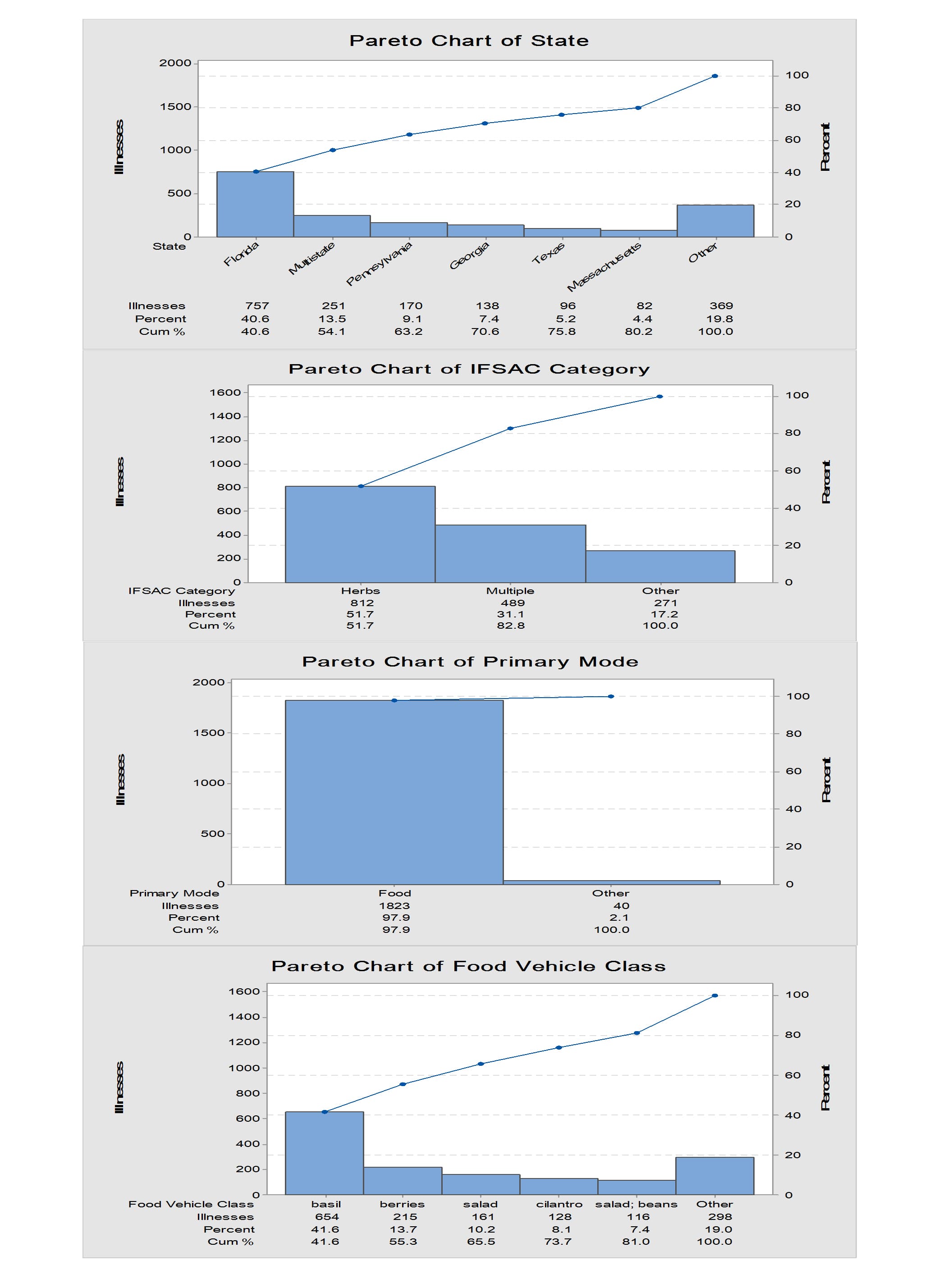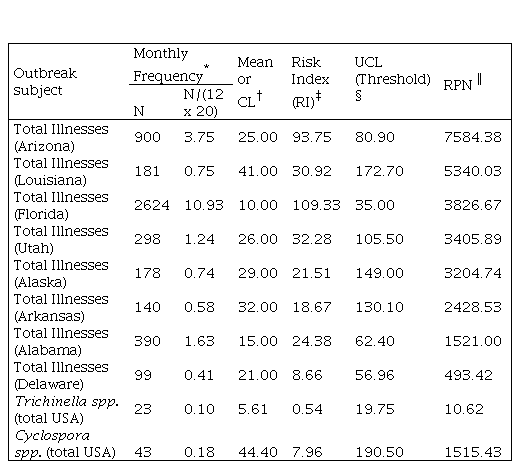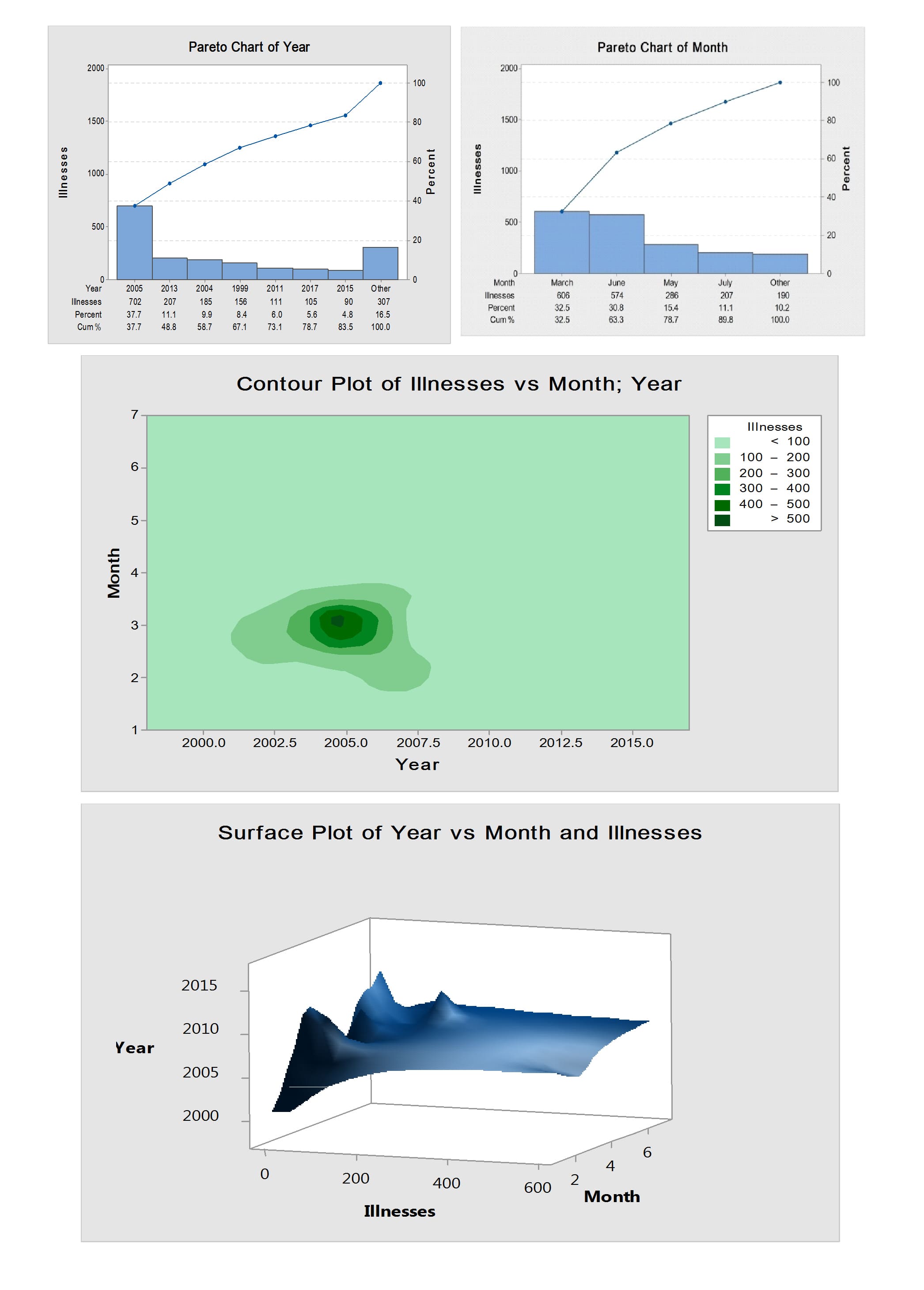INTRODUCTION
The human parasite Cyclospora cayetanensis is belonging to Phylum Apicomplexa under Supergroup SAR (Alveolata Group) of cyst-former protozoa that form round oocyst and causing self-limited diarrhea [1]. The cyst could be described as [O.2.2] which indicates that one oocyst contains a duplicate sporocyst and every sporocyst contains double sporozoites [2]. Cyclosporiasis outbreak is one of the events that are monitored by the National Outbreaks Reporting System (NORS) internet platform adopted by the Centers for Disease Control and Prevention (CDC) to record outbreak incidents across the USA [3]. These commonly implicated foods can harbor sporulated oocysts which come from the excretion of unsporulated oocysts in feces of infected individuals and people get infected by ingestion of those contaminated foods.In the next sections, Statistical Process Control (SPC) tools could provide unique perspective descriptive analysis for Cyclosporiasis outbreaks in USA after long-term monitoring from official web-based data source.
ECOLOGICAL OBSERVATIONAL STUDY
The magnitude of the outbreaks is measured by the number of affected individuals per a single event. Figure 1 shows the chronological distribution of the number of illnesses during monitoring and recording period of 20 years for Cyclosporiasis outbreak. Major excursion in the number of sickness cases by more than 67 % from a period from 1998 to 2017 could be observed in years 2005, 2013, 2004 and 1999 during meteorological spring, and summer periods with the number of illness above 78 %. A rectangular level plot demonstrates the exact maximum spiking of the outbreak in March 2005 by more than 500 illnesses. On the other hand, the surface plot pinpoints to the main periods of elevated levels of outbreaks as a function of time illustrated as peaks.
Outbreaks involving Cyclospora cayetanensis -excluding multistate record- were spotted mainly in Florida (40.6 %), Pennsylvania (9.1 %), Georgia (7.4 %) and Texas (5.2 %) which amounts totally to 62.3 % from the overall states encountered in this disease. Pareto plot shows this ranked distribution among USA states in Figure 2. The primary mode for the transfer of this Eucoccidioridian protozoan is food sources and water to a much lower extent with herbal ingredients based on Interagency Food Safety Analytics Collaboration (IFSAC) classification affecting more than half of the recorded cases. Food vehicles that have been traced to be contaminated from were basil, berries, salad, cilantro, salad, and beans for four-fifths of the outbreak illnesses as could be seen in Figure 2. This commonly implicated food harbor sporulated oocysts which come from the contaminated environment due to excretion of unsporulated oocysts in feces of infected individuals from contaminated food ingestion [4].

Figure 2. Pareto diagram of the major USA states affected by Cyclospora cayetanensis outbreaks during monitoring period of 20 years, primary mode of disease transfer and the main food vehicles in addition to IFSAC categories involved in Cyclospora cayetanensis outbreaks during monitoring period from 1998 to 2017.
An application of statistical software packages would allow for detailed monitoring of the general trend of the monitored outbreak (Figure 3). Two types of control charts were used Laney-modified attribute process-behavior trend showing the magnitude of illness per outbreak arranged in ascending chronological order (denoted by sample number in Figure 3) and rare event G chart demonstrating intervals between outbreak events with a probability of occurrence for Cyclospora cayetanensis outbreak per month is 0.144. The unusual excursion in the number of ill individuals (marked by no.1 red dot) occurred in March 2005 in Florida restaurant settings as could be found in NORS database and visualized in attribute chart of Figure 3. Shewhart chart consists of upper control limit (UCL), lower control limit (LCL) and control limit (CL) or mean of the inspected property. From the attribute control chart parameters, a modified quantitative risk probability number (RPN) could be calculated as a modified tool for hazard analysis [5, 6]. Table 1 shows comparative risk analysis at different dimensions from NORS database where for randomly selected segregated samples of data analysis using control charts were done and the output parameters were used for the quantitative hazard evaluation to the public health from Cyclospora cayetanensis outbreak illnesses in the USA.For example, quantitative RPN of Cyclospora spp. outbreaks through the whole country are comparable to that of the overall outbreaks from all recorded etiological agents in Alabama State during the same period. However, it is much less than Arizona and higher than Delaware. Moreover, Trichinella spp. outbreak incidences impose much lower risk in comparison with that of Cyclospora spp.
DISCUSSION
Previous studies have shown the same seasonal prevalence of the disease outbreaks through the years with the main vehicles were found to come from food sources of similar types [6]. Despite several reported and documented pieces of evidence for water-borne outbreaks from Cyclospora spp., they represent a minor route of infection from the overall observations which were reported here from NORS and in agreement with that concluded from other researchers [7, 8]. This emerging disease problem continues to cause outbreak problems as more than 60 laboratories confirmed the presence of Cyclosporiasis in seven states in 2018 following the consumption of salads from fast food company and two patients were hospitalized [9, 10]. This disease is treatable using Trimethoprim-Sulfamethoxazole (TMP-SMX) and it was noticed that it was the only highly effective treatment for Cyclosporiasis till now [11]. It should be noted that there are several obstacles which callenge the methods of diagnosis of Cyclosporiasis for traceability and recording of the empidemiological data. One of the callenges is related to the nature of the non-homogenous distribution of the parasite in the specimens which is present already with very low density that makes microscopical examination non-convenient [12].
Also, regulatory agencies have updated their techniques and technologies for the detection of the parasite recently since the previous method was outdated and the equipment and instruments required were no longer being manufactured or produced. The tracing of Cyclosporiasis outbreak in many instances tends to be very difficult because of its complicated life cycle - in contrast to the bacterial epidemiology - the onset of the disease may take several days (incubation period sometimes >10 days) and patients may not seek the appropriate authorities timely. Thus, the investigations may be significantly delayed, and the evidence and samples may be lost, spoiled or no longer available after such a long time [12]. Nevertheless, this relatively newly emerging disease should be monitored with caution as it has worldwideimpact in rich and poornations with the world of an ever-increasing cases of health-deficient populations which might complicate their treatment and recovery, in addition, to aggravation the effect and the magnitude of Cyclosporiasis epidemiology.
Table 1. Quantitative Risk Probability Number (RPN) calculated using modified hazard analysis tool based on attribute control chart [5, 6]. * Rate of occurrence of the outbreaks of Cyclospora cayetanensis† Average obtained from construction of Laney-control charts. ‡ Product of multiplication of [ ]§ Upper tolerance threshold before the brink of excursion from Laney-control charts.║Quantitative risk value obtained by the multiplication of RI with UCL

















